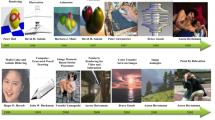Abstract
Visual comfort assessment (VCA) for stereoscopic images is a particularly significant yet challenging task in 3D quality of experience research field. Although the subjective assessment given by human observers is known as the most reliable way to evaluate the experienced visual discomfort, it is time-consuming and non-systematic. Therefore, it is of great importance to develop objective VCA approaches that can faithfully predict the degree of visual discomfort as human beings do. In this paper, a novel two-stage objective VCA framework is proposed. The main contribution of this study is that the important visual attention mechanism of human visual system is incorporated for visual comfort-aware feature extraction. Specifically, in the first stage, we first construct an adaptive 3D visual saliency detection model to derive saliency map of a stereoscopic image, and then a set of saliency-weighted disparity statistics are computed and combined to form a single feature vector to represent a stereoscopic image in terms of visual comfort. In the second stage, a high dimensional feature vector is fused into a single visual comfort score by performing random forest algorithm. Experimental results on two benchmark databases confirm the superior performance of the proposed approach.





Similar content being viewed by others
References
Hur, N., Lee, H., Lee, G., Lee, S., Gotchev, A., & Park, S. (2011). 3DTV broadcasting and distribution systems. IEEE Transactions on Broadcasting, 57(2), 395–407.
Lambooij, M., Ijsselsteijn, W., Fortuin, M., & Heynderickx, I. (2009). Visual discomfort and visual fatigue of stereoscopic displays: A review. Journal of Imaging Science and Technology, 53(3), 1–14.
Tam, W., Speranza, F., Yano, S., Shimono, K., & Ono, H. (2011). Stereoscopic 3D-TV: Visual comfort. IEEE Transactions on Broadcasting, 57(2), 335–346.
Urvoy, M., Barkowsky, M., & Le Callet, P. (2013). How visual fatigue and discomfort impact 3D-TV quality of experience: a comprehensive review of technological, psychophysical, and psychological factors. Annals of Telecommunications-Annales Des Télécommunications, 68(11–12), 641–655.
A. Mittal, A. Moorthy, J. Ghosh, and A.C. Bovik (2011) Algorithmic assessment of 3D quality of experience for images and videos, Proceedings of IEEE Digital Signal Processing Workshop, pp. 338–343
Lambooij, M., IJsselsteijn, W., & Heynderickx, I. (2011). “Visual discomfort of 3D TV: Assessment methods and modeling”. Displays, 32(4), 209–218.
Ukai, K., & Howarth, P. (2008). Visual fatigue caused by viewing stereoscopic motion images: Background, theories, and observations. Displays, 29(2), 106–116.
Yano, S., Ide, S., Mitsuhashi, T., & Thwaites, H. (2002). A study of visual fatigue and visual comfort for 3D HDTV/HDTV images. Displays, 23(4), 191–201.
Kim, D., & Sohn, K. (2011). Visual fatigue prediction for stereoscopic image. IEEE Transactions on Circuits System and Video Technology, 21(2), 231–236.
Choi, J., Kim, D., Choi, S., & Sohn, K. (2010). Visual fatigue modeling and analysis for stereoscopic video. Optical Engineering, 51(1), 017206.
Jiang, Q., Shao, F., Jiang, G., Yu, M., & Peng, Z. (2015). Three dimensional visual comfort assessment via preference learning. Journal of Electronic Imaging, 24(4), 043002.
Borji, A., & Itti, L. (2013). State-of-the-art in visual attention modeling. IEEE Transactions on Pattern Analysis and Machine Intelligence, 35(1), 185–207.
Sohn, H., Jung, Y., Lee, S., & Ro, Y. (2013). Predicting visual discomfort using object size and disparity information in stereoscopic images. IEEE Transactions on Broadcasting, 59(1), 28–37.
Lee, S., Jung, Y., Sohn, H., Speranza, F., & Ro, Y. (2013). Effect of stimulus width on the perceived visual discomfort in viewing stereoscopic 3D-TV. IEEE Transactions on Broadcasting, 59(4), 580–590.
Jung, Y., Sohn, H., Lee, S., Park, H., & Ro, Y. (2013). Predicting visual discomfort of stereoscopic images using human attention model. IEEE Transactions on Circuits System and Video Technology, 23(12), 2077–2082.
Breiman, L. (2001). Random forests. Machine Learning, 45(1), 5–32.
Gu, K., Zhai, G., Yang, X., & Zhang, W. (2015). Using free energy principle for blind image quality assessment. IEEE Transactions on Multimedia, 17(1), 50–63.
Itti, L., Koch, C., & Niebur, E. (1998). A model of saliency-based visual attention for rapid scene analysis. IEEE Transactions on Pattern Analysis and Machine Intelligence, 20(11), 1254–1259.
Harel, J., Koch, C., Perona, P. (2006) Graph-based visual saliency, Proceedings of Advances in Neural Information Processing Systems.
Goferman, S., Zelnik-Manor, L., & Tal, A. (2012). Context-aware saliency detection. IEEE Transactions on Pattern Analysis and Machine Intelligence, 34(10), 1915–1926.
Hou, X., Harel, J., & Koch, C. (2012). Image signature: Highlighting sparse salient regions. IEEE Transactions on Pattern Analysis and Machine Intelligence, 34(1), 194–201.
Li, J., Levine, M., An, X., Xu, X., & He, H. (2013). Visual saliency based on scale-space analysis in the frequency domain. IEEE Transactions on Pattern Analysis and Machine Intelligence, 35(4), 996–1010.
Martinel, N., Micheloni, C., & Foresti, G. L. (2015). Kernelized saliency-based person re-identification through multiple metric learning. IEEE Transactions on Image Processing, 24(12), 5645–5658.
Lang, C., Nguyen, T., Katti, H., Yadati, K., Kankanhalli, M., Yan, S. (2012). Depth matters: Influence of depth cues on visual saliency. In Proceeding of 12th European Conference on Computer Vision (ECCV).
Park, J., Lee, S., & Bovik, A. (2014). 3D visual discomfort prediction: Vergence, foveation, and the physiological optics of accommodation. IEEE Journal of Selected Topics in Signal Processing, 8(3), 415–426.
Final report from the video quality experts group on the validation of objective models of video quality assessment VQEG, 2000. http://www.vqeg.org
Acknowledgments
This work was supported in part by Natural Science Foundation of China (Grant No. 61501270), in part by Zhejiang Provincial Natural Science Foundation of China (Grant No. LY14F010004), in part by Open fund of Zhejiang Provincial Key Academic Project (first level), in part by College Students Science and Technology Innovation Project (Xin Miao Talent Project) of Zhejiang Province (2014R405077), in part by Ningbo Natural Science Foundation (2016A610071), and in part by the Scientific Research Foundation of Ningbo University (XYL15025).
Author information
Authors and Affiliations
Corresponding author
Rights and permissions
About this article
Cite this article
Zhang, W., Luo, T., Jiang, G. et al. Using Saliency-Weighted Disparity Statistics for Objective Visual Comfort Assessment of Stereoscopic Images. 3D Res 7, 17 (2016). https://doi.org/10.1007/s13319-016-0079-6
Received:
Revised:
Accepted:
Published:
DOI: https://doi.org/10.1007/s13319-016-0079-6




